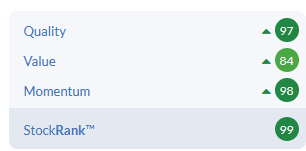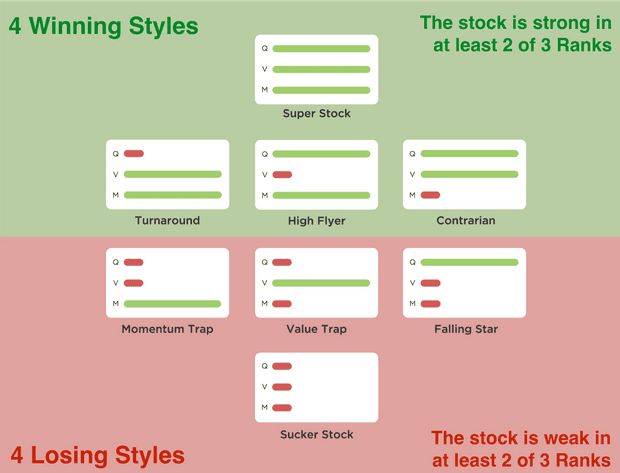How (and why) the StockRanks can help you find shares
The stock market can be an overwhelming place, especially for new investors. With around 1,500 listed companies in the UK alone, narrowing down this selection to a manageable universe is not easy.
Our StockRanks system has been developed to help investors make sense of the market and easily identify shares that are statistically more likely to perform well.
This does not mean that stocks with high StockRanks are guaranteed to be winners. No system can offer that guarantee.
What we do instead is to draw on the findings of decades of academic research and real-world stock market history. These tell us that by using financial factors – metrics such as profitability and valuation ratios – we can assign meaningful rankings to stocks.
The StockRanks can be used as a tool to build portfolios or simply as a starting point for more in-depth research.
We believe they offer many other advantages for private investors, too. One benefit that may be underrated is the objectivity provided by a consistent ranking system.
As humans, we all struggle with behavioural biases such as anchoring, loss aversion and confirmation bias. But an objective scoring system will simply see the facts in a consistent way, making it easier for us to remain clear headed and – hopefully – seize opportunities.
Read on to see how – and why – the StockRanks can be used to help investors find attractive new shares.
StockRanks: Three core factors
We score all stocks based on three core factors, each of which is assigned its own rank.
Quality Rank: how good is the stock? Quality businesses are typically high margin, cash generative and have strong finances.
Value Rank: how cheap is the stock? Value stocks may be out of favour and typically look cheap on valuation measures, relative to their earnings and assets.
Momentum Rank: is the stock winning? Shares with strong momentum typically have rising shares prices and recently-upgraded broker earnings estimates.
Each of these scores is useful in its own right as a guide to the characteristics of a stock and the likely investment strategy it may suit.
For example, a contrarian investor might seek shares with high quality and value ranks, but a low momentum score, signifying a good business that’s currently out of favour.
However, we believe these individual factor ranks offer the greatest benefit when they’re combined into an overall StockRank – a QVM score.
StockRank: shares with the highest StockRanks are likely to show high scores for quality, value and momentum. This doesn’t mean they’re perfect or infallible – but they are statistically more likely to be able to outperform the market.
Here’s an example of a share with a high StockRank:
It’s worth pointing out that a high StockRank will not prevent shares falling sharply in a market crash. Stock market investments always carry the risk of losses. But a business with strong factor scores may be able to recover more quickly and completely than a weaker business.
StockRank Styles: keeping it simple!
StockRanks contain a lot of numbers. They’re not always easy to instantly digest and understand. We get it!
To make it easier to see where stocks sit in terms of style and character, we’ve devised a set of eight StockRank Styles. These classify stocks according to their factor scores:
You can read more about these styles elsewhere in the Academy, but we hope they’re fairly self-explanatory.
How to use the StockRanks to find shares
The StockRank system is designed to facilitate your own style of investing, rather than proscribing a specific approach.
Here are a few examples of how the StockRanks can be used to help build a portfolio.
Use StockRanks + a simple diversification strategy: essentially, this is the approach used by Stockopedia founder Ed Croft’s successful NAPS portfolio.
There are lots of ways this approach can be tweaked, but a simple example might be choosing the two highest-ranked stocks from each of the 10 economic sectors. Doing this would create a portfolio of 20 shares, with a fairly broad mix of businesses.
The stocks in the portfolio would then need to be reviewed every 12 months, and if necessary, replaced with the current highest-ranking stocks in each sector.
Diversification is important in a strategy like this, where there’s only minimal investor research into each stock purchased.
Choosing 20 holdings means that if one share falls by 50%, the loss on the original portfolio value would be 2.5%. It’s worth considering scenarios such as this to make sure you’re comfortable with your loss exposure.
StockRanks + strategy: an evolution of the core StockRanks approach is to follow the strategy above, but select stocks based on a factor rank pair such as Quality+Value or Value+Momentum.
These combined values (QV, QM & VM) can all be screened and searched for in the Stockopedia app.
An investor following this approach might need to consider different timeframes for holding shares. Some of these issues are discussed in the portfolio management section of the Academy.
Sector specialist: for an investor with an interest in particular sectors, the StockRanks can be a powerful tool for sorting shares in order of research priority.
Higher-ranked stocks might be worth spending more time on, as they should have a greater probability of success.
Stock comparison: for investors wanting to compare the relative characteristics of several shares, the QVM factor ranks can be useful when used in the Compare tool.
Here’s an example, comparing three companies from the same sector. Although these companies may seem similar at first glance, we can see that there are significant differences in quality, valuation and momentum between them:
These differences would be likely to influence an investor’s view on a company, so a comparison like this can be a good starting point for more in-depth research.
Single factor focus: finally, investors with a total focus on a single factor – quality, value or momentum – can sort and filter stocks in their investable universe using this factor alone.
However, the performance of a single factor alone has historically been a less reliable indicator of likely performance than the combined StockRank score.
For this reason, we would suggest that this approach is only suitable for an investor who is willing and able to carry out further in-depth research into each stock, before making any trading decisions.



